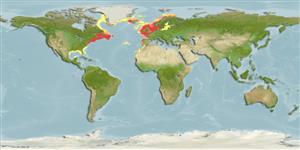Classificação / Names
Common names from other countries
Referência principal
Tamanho / Peso / Idade
Max length : 41.0 cm TL macho/indeterminado; (Ref. 1371); common length : 30.0 cm TL macho/indeterminado; (Ref. 1371); Idade máx. registada: 9 anos (Ref. 1371)
Length at first maturity
Lm 25.0, range 15 - ? cm
Ambiente
; marinhas demersal; oceanódromo (Ref. 51243); intervalo de profundidade 20 - 650 m (Ref. 6144), usually 20 - 50 m
Clima / Intervalo
Temperate, preferred 6°C (Ref. 107945); 73°N - 20°N, 99°W - 32°E (Ref. 1371)
Distribuição
Northwest Atlantic: northern Gulf of Mexico to Newfoundland, western Greenland. Northeast Atlantic: coasts of Europe and the British Isles from the Barents Sea to the northern Bay of Biscay. One locality at Cape Blanc, Mauritania. Reported from Estonia (Ref. 33247). Caught very rarely in the Far East (Ref. 94563).
Países | Áreas FAO | Ecossistemas | Ocorrências | Introduções
Descrição breve
Espinhos dorsais (total): 0; Espinhos anais 0. One barbel on chin, one on tip of snout, and one at each of the anterior nostril. First dorsal fin ray very elongate, followed by a row of small, fleshy filaments. Color varies from dusky to pale.
Categoria na Lista Vermelha da IUCN (Ref. 115185)
Ameaça para o homem
Harmless
Utilização humana
Pescarias: pouco comercial
Mais informação
ReferênciasAquaculturaPerfil para aquaculturaEstirpesGenéticaFrequência dos alelosHereditariedadeDoençasProcessamentoMass conversion
Ferramentas
Relatórios especiais
Descarregue XML
Fontes da internet
Estimates of some properties based on models
Phylogenetic diversity index
PD50 = 1.0000 many relatives (e.g. carps) 0.5 - 2.0 few relatives (e.g. lungfishes)
Nível Trófico
3.5 ±0.0 se; Based on diet studies.
Resiliência
Médio, tempo mínimo de duplicação da população 1,4 - 4,4 anos (K=0.20-0.25; tm=3; tmax=9; Fec=5,000)
Vulnerabilidade
Moderate to high vulnerability (46 of 100)
Categoria de preço
